
Product test
Fanless, purple 12-inch Microsoft Surface Pro review: generally good, but…
by Martin Jud
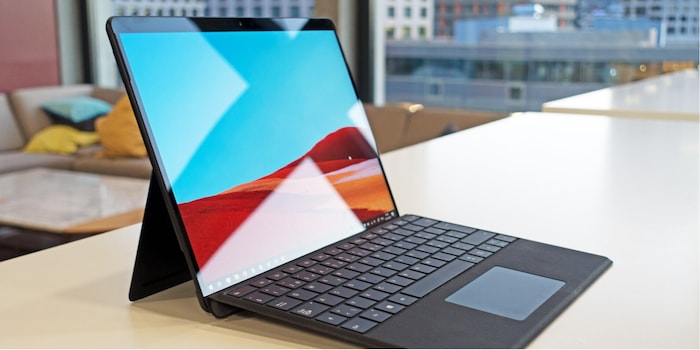
Microsoft has done a lot of things right with the Surface Pro X. Not only is the almost borderless display appealing, but the new inductively charging slim pen and the "pen garage" are also impressive. The downside is the ARM processor, which severely limits functionality.
The technical data of the test device:
The Surface Pro X looks to me like the perfection of the [Surface Pro 7]/en/page/microsoft-surface-pro-7-tested-final-usb-c-and-ice-lake-u-processors-14440). This gives you a display that is 0.7 inches larger despite having roughly the same surface area of 287 x 208 mm and has been pulled a lot closer to the edge of the tablet. It is also 1.2 mm thinner with a thickness of 7.3 mm. The Pro X weighs 774 g without the keyboard.
Under the stand, the Pro X lacks the microSD slot familiar from the Pro 7. Instead, you have the option of inserting a nano SIM card under the stand or replacing the SSD yourself. There are also two USB 3.1 Type-C ports and the volume rocker on the left-hand side of the device. The power button and Surface Connect port are located on the right-hand side. A classic 3.5 mm jack connection is unfortunately missing.
The 13-inch high-gloss display with IPS panel has a resolution of 2880 x 1920 pixels and comes in the typical Microsoft 3:2 format. Thanks to the high resolution, employees can have a lot of fun with the pen - even if you get your head close to it, you won't be able to see any pixels.
To find out how well the display is illuminated, I measure it with the x-rite i1Display Pro:
Officially, the display is supposed to have a brightness of 450 cd/m². I measured an average of 490.66 cd/m², which is a very good value for a tablet or notebook. It is also evenly lit, and the 25 cd/m² difference between the brightest and darkest areas is not visible to the naked eye.
In terms of colour space coverage, the display manages to display a spectrum of 94 per cent in sRGB. For Adobe RGB it is 64.8 per cent and for DCI P3 66.7 per cent. When I measure the black and white values, I calculate a crisp, static contrast of 1348:1. The dynamic contrast is 5841:1.
When you buy the Surface Pro X, the keyboard and pen are unfortunately not included. The Alcantara-covered keyboard, which turns the device into a notebook, is available in two versions. One with a pen and one without. If you order the version with a pen, you also get an integrated "pen garage". The pen is not only neatly stored inside - it also charges itself thanks to induction.
Unfortunately, Microsoft only sells the keyboard with pen garage including the pen. If you choose a keyboard without a pen, there is no pen garage. If you buy a pen in the future, you will only be able to charge it externally. Incidentally, the pen is no longer round but flat, which is a great adjustment. This makes it even easier to hold. It makes drawing and writing a real pleasure.
The 310 gram keyboard can be used flat or slightly angled. The keys have three-stage illumination. When you type on the 29.5 x 21.7 x 0.5 cm keyboard, the keys bounce comparatively strongly and you feel a clear trigger point. I find typing pleasant and quiet. There is nothing to criticise about the trackpad with multi-finger gesture support.
Microsoft gives the Surface Pro X a lithium-ion battery with 38.2 Wh. I eagerly measure how long it lasts on YouTube in a continuous loop, try a stress test and measure the runtime when working in the office.
I set the brightness of the display to 150 cd/m² and run music videos on YouTube until the device can take no more. The automatic shutdown comes after 8 hours and 31 minutes. That's a good performance. But I'm surprised that the Pro X doesn't last even longer, because compared to other convertibles with a normal processor, this is no mean feat.
In order to push all the hardware to its limits, I usually run the stress test HeavyLoad and FurMark at the same time with the screen set to maximum brightness. But unfortunately both programmes don't want to do what I want.
Well, this device can't be stressed. But it's starting to stress me out, because that's how it works with many programmes on this device. You have to be aware of this before you buy it.
If I use the convertible as a mobile office and refrain from running YouTube in the background, I get around twelve hours of battery life, depending on my work. That's a good value for an office device. I can't say whether it's good for an ARM Windows device due to the lack of a basis for comparison.
The Microsoft SQ1 is an SoC based on the Qualcomm Snapdragon 8cx Compute Platform. It is manufactured using the 7 nm process at TSMC and has 8 cores (and 8 threads), half of which are power cores. Four cores are based on the ARM Cortex-A76 and can clock up to 3 GHz, while the power-saving cores are based on the ARM Cortex-A55 and are presumably clocked at up to 1.8 GHz.
The SoC also integrates an X24 LTE modem, navigation systems (GPS, Galileo and others), video decoder and encoder for H.265, Bluetooth 5.0, Wi-Fi 5, a memory controller and a graphics chip. The latter is an Adreno 685, which is presumably also clocked slightly higher than the standard model. Microsoft itself speaks of a theoretical graphics performance of two TeraFLOP.
To test the performance, I would like to use PCMark 10, Cinebench R20 and Geekbench 5.
Unfortunately, only the CPU benchmark from Geekbench works. With the other two there are again nice error messages.
Geekbench 5 results of the Surface Pro X:
When I search for similar results in the Geekbench browser, this result does indeed correspond to an Intel Core i5, as claimed by Qualcomm. Not one of the eighth generation, however, but rather one of the fourth (Intel Haswell microarchitecture) from 2013.
If you want to see the CPU benchmark result in detail:
The bottom line is that the device scores full marks for looks and workmanship. However, I can't recommend it in terms of software. You'd be better off with a Surface Pro 7, on which the new Slim Pen also works, or another convertible. <p
I find my muse in everything. When I don’t, I draw inspiration from daydreaming. After all, if you dream, you don’t sleep through life.
If Microsoft were to remove the "Pro" from the name of this device and sell it a little cheaper, I would be thrilled. Because it's not bad in itself and, above all, looks damn good. But unfortunately, as soon as you look at the specifications, it becomes clear that the built-in processor makes it impossible to use this device for professional use outside of Office. As Microsoft has installed a processor with ARM architecture, classic Windows applications have to be emulated. However, all 64-bit applications and those that require an additional driver are excluded from emulation.
For example, the use of the ARM processor means that not a single programme from the Adobe Creative Cloud works more precisely. All programmes that require an OpenGL version above 1.1 (i.e. practically all of them) are also not supported. Running benchmarks with this device is also hell - only Geekbench lets me at least test the CPU. If you want to install Virtual CloneDrive, it won't work because of the lack of driver support. In general: It's a damn lottery whether a software works on this device at the current time or not. And if it does run, the performance is affected by the emulation.

Microsoft uses anodised matt black aluminium for the casing, which feels very good to the touch. As the design is fanless, the cooling groove around the device typical of the Surface Pro and Go is missing. The heat on this tablet is to be dissipated by a carbon fibre composite material. The stand is identical to the Pro 7 and Go, which is particularly useful when writing or drawing with a pen, as it allows the display to be positioned at any angle. One annoying thing about the stand is that the tablet is not always stable when used on the lap.
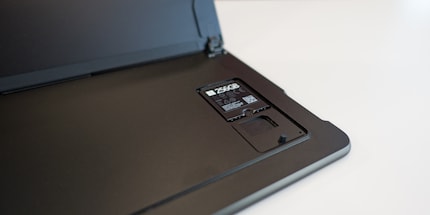

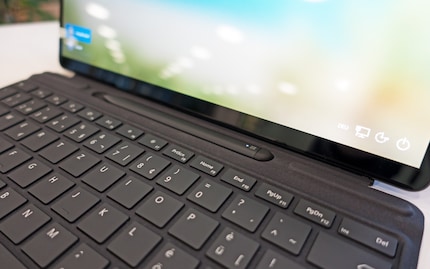
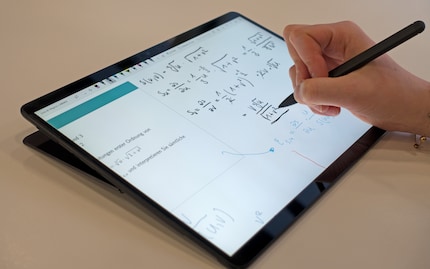
The stereo speakers with 2 watts of power are located in the upper part to the left and right of the display. As with the Surface Pro 7, these speakers are also certified with Dolby Audio Premium, which does not necessarily make the sound any better. However, the sound image appears much wider than the distance between the speakers themselves. Compared to the Surface Pro 7, which has good mini speakers, the bass range of the sound is a little worse, but I like the mids and highs. All in all, they are decent notebook speakers.
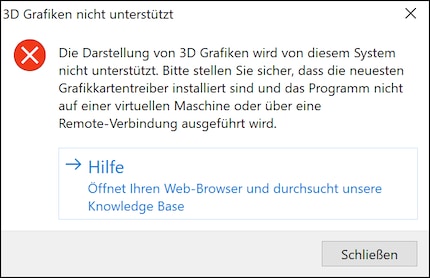

Qualcomm claims that the performance of the processor cores with software compiled for ARM64 comes close to an eighth-generation Intel Core i5. I strongly doubt this - if only because there is no way to verify this claim or to test an ARM64 application on a processor without ARM architecture and without emulation. Apart from that, theoretical performance is of no use to me if there is a lack of good software that can actually call it up. Nevertheless, I will check the performance below with non ARM64 compiled benchmark. As already mentioned, 64-bit apps compiled for AMD or Intel do not run at all. 32-bit apps run in a slow emulation.


Geekbench 5 is a cross-platform benchmark. In addition to simulated real-world scenarios with which the CPU is tested (single-core and multi-core), Geekbench can also determine GPU performance in the areas of image processing and machine vision. However, this is not possible with an ARM processor under Windows. If you want to compare Geekbench results with other systems, you can do this with the Geekbench browser.
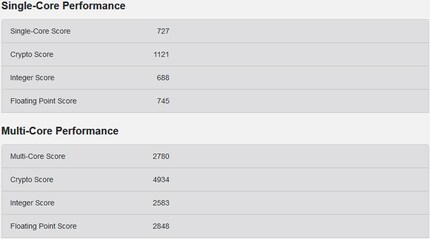
Microsoft is playing too much poker with the Surface Pro X. Especially since it is overpriced in view of the relatively puny performance and poor programme compatibility. Nevertheless, the device excites me in the areas where it can be used. If pen input is important to you, you will probably have to look far and wide to find something better for writing and drawing. The new Slim Pen is not only ingenious because it can be safely stored and charged in the keyboard's "pen garage". Its new thinner shape and the feel on the brilliant high-resolution and bright display are also impressive.